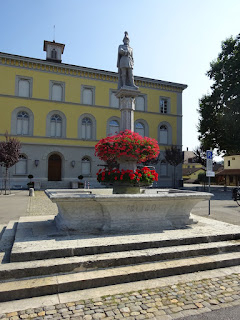Groningen, population 200,000, is the largest city in the northern part of the Netherlands. It's home to the University of Groningen (30,000 students) and Hanze University of Applied Sciences (25,000). The beautiful building below is Goudkantoor or Gold Office. Built in 1635 it's where one went to have a hallmark stamped on your gold or silver to prove it was real. Now it's home to a restaurant.
Martini Tower dates back in 1482. It seems the Dutch have a problem building towers as the tower tilts 0.6 meters.
This is the main building at the University of Groningen.
This is a photo of the same square as the photo above except facing the other way. See the man in the blue shirt standing in front of his white truck? A few seconds earlier he was standing front of the white "no smoking" sign puffing away on a cigarette. He saw me taking his picture and tossed the cigarette. There are three other "no smoking" signs nearby and four more "no smoking" signs taped to the building. Evidently the university is tired of students smoking up a storm. But the idiot in the blue shirt thinks the sign doesn't apply to him.

Making my way back to Switzerland means passing through Germany and places I've visited (and posted pictures) before. Dusseldorf, population 600,000, doesn't look as inviting as it did during my last visit. Why? There has been a prolonged heat wave (mid-90's) and no rain for several weeks. Pictured below is the beginning of The Koenigsalle (King's Avenue), one of Europe's fanciest shopping streets. It's about a half-mile long and a tree-shaded canal runs through the middle. Luxury high-end stores line the boulevard but, this photo shows parched grass. You'd think they would install a sprinkler system to insure a lush look and enhance the shopping experience but no, this is Europe.

I've talked about the 10 year rule before. Trends start in California and in five years they are in New York City and 10 years arrive in Europe. Classic example: frozen yogurt shops. Anyway, Mexican taco shops is another. Europe was clueless about Mexican food--I remember going into a Mexican restaurant in Finland and it looked like they took Heinz ketchup mixed it with a few red peppers and---voila---called it salsa! Nowadays, good Mexican fast-food places pop up everywhere. This one in Dusseldorf is called "Chidonkey"---how the heck they came up with that? Very good food!!
Signs are in English. Had several excellent steak tacos along with a Corona beer.
Okay, it's time for your history lesson. Bonn, population 300,000, was the capital of West Germany from 1949-1990. With the reunification of communist East Germany and West Germany in 1990, Bonn was designated the capital. However, in 1999 the powers that be voted to move the capital to Berlin. So, overnight Bonn went from being relevant to being a has-been. There's not much of a old town area in Bonn. This is city hall (built in 1737). When world leaders visited Bonn it was pretty much mandatory they appear on the steps outside city hall with local officials and wave. Photos show French president Charles de Gaulle, Russian presidents etc.. giving the wave to the crowd. Nowadays, since Bonn's decline, I imagine if I slipped 20 bucks to someone at city hall they'd walk me out the steps for a photo-op.

Imagine if the capital of the United States was moved from Washington D.C. to New York City. Embassies would pack up and move and ditto all those companies with fancy offices for their lobbyists. A clear example of Bonn's fall from power: Deutsche Bahn, Germany's railway (the world's largest railway company) for the past 20 years has been renovating/upgrading train stations around the country. In Bonn the train station is a real dump and is currently undergoing renovations--bet this would have been done years and years ago if it was still the capital. This photo shows market day in Bonn's main square.

At the edge of town is where you find most of Bonn's government complexes. I held my camera through a fence to snap Villa Hammerschmidt, from 1950-1999 the official residence of the President of Germany--a mostly ceremonial position. Germany's Chancellor holds the real power, currently Angela Merkel, and her former official residence is a stark modernistic structure almost adjacent to this villa. Nearby, the former German Parliament complex has been handed over to the United Nations.
I think what's really funny is the modern 41-story Deutsche Post DHL Tower looming over the former parliament complex. Started in 2000, do you think Deutsche Post DHL, with over 510,000 employees and $64 billion in revenues (the world's largest postal/courier service), would have built the tower if they had known the government would be moving? No way Jose, I'm sure it was a matter of already having secured the funding for the building. So much for their plan of walking next door to schmooze government officials.
I visited Deutsche Telecom ($84 billion in revenues) here back in 1995 and they still call the huge building complex (located several blocks from the former German Parliament complex with over 2,000 employees ) their head office but signs say it's an employee training center.
Been through Mainz (population 200,000) multiple times and posted pictures but, as mentioned earlier it's the route back to Switzerland. So, I've posted several pictures from the old town area.
This couple looks like they've had a good shopping day.
View of the red sandstone colored Mainz Cathedral.
Flowers outside city hall.



















































